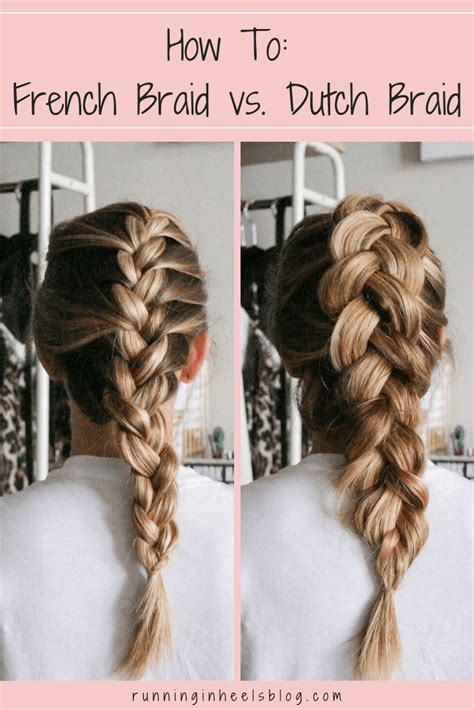Introduction

The world of hair braiding offers an endless array of styles, with Dutch braids and French braids topping the list of must-try techniques. Both these braiding methods create intricate and eye-catching looks, but they possess distinct characteristics that cater to different preferences and hair types. This article delves into the nuances of Dutch braids vs. French braids to help you determine the perfect match for your style and hair texture.
Dutch Braids: An Inside-Out Masterpiece
Dutch braids, also known as inside-out braids, derive their name from the Dutch tradition of elaborate hair braiding. These braids are characterized by their inverted weaving pattern, where the hair strands are crossed under instead of over each other. This creates an elevated effect, making Dutch braids a popular choice for adding volume and height to hair.
Key Features of Dutch Braids:
- Inverted weaving pattern (crossing strands under instead of over)
- Elevated look, adding volume and height
- Typically tighter than French braids
- Ideal for creating statement hairstyles
- Suitable for all hair types, especially thick or coarse hair
French Braids: An Elegant and Versatile Classic
French braids, the epitome of classic hair braiding, have been a staple in hairstyles for centuries. These braids are crafted by gradually adding hair to the braid from the sides as you weave it down the length of your hair. The result is a smooth, intricate braid that exudes elegance and versatility.
Key Features of French Braids:
- Over-under weaving pattern (crossing strands over each other)
- Traditional and elegant appearance
- Less bulky than Dutch braids
- Can be styled in a wide variety of ways
- Suitable for all hair types, particularly fine or straight hair
Comparing Dutch Braids and French Braids
To further illustrate the differences between Dutch braids and French braids, consider the following table:
| Feature | Dutch Braid | French Braid |
|---|---|---|
| Weaving Pattern | Under-Over | Over-Under |
| Appearance | Elevated, Voluminous | Smooth, Intricate |
| Tension | Tighter | Looser |
| Hair Type | Thick, Coarse | Fine, Straight |
| Statement Value | High | Medium |
| Versatility | Limited | High |
Which Braiding Technique is Right for You?
The choice between Dutch braids and French braids ultimately depends on your personal style and hair type.
- For those seeking a bold and voluminous look: Dutch braids are an excellent option, particularly for thick or coarse hair.
- For a more traditional and versatile style: French braids are the ideal choice, as they can be styled in various ways and complement fine or straight hair textures.
- For creating intricate and elaborate hairstyles: Dutch braids offer a more dramatic effect, making them perfect for special occasions or statement looks.
- For a quick and easy braiding option: French braids are less time-consuming and can be easily incorporated into everyday hairstyles.
Tips and Tricks for Mastering Dutch and French Braids
- Section and moisten your hair: Divide your hair into sections and lightly dampen it for easier braiding.
- Use small strands: Start with small sections of hair to ensure precision and avoid tangles.
- Keep tension even: Apply consistent pressure while braiding to prevent uneven results.
- Practice makes perfect: The key to mastering either braiding technique is practice. Dedicate time to experimenting with different sections and hair types.
- Experiment with different variations: Explore variations such as crown braids, fishtail braids, and half-up styles to add variety to your braiding repertoire.
Innovative Applications of Dutch and French Braids
Beyond traditional hairstyles, Dutch and French braids offer numerous creative possibilities:
- Hair Accessories: Incorporate Dutch or French braids into headbands, hair wraps, and barrettes for a touch of elegance.
- Bridal Hairstyles: Create elaborate updos and buns by combining Dutch and French braids for a truly memorable bridal look.
- Braided Extensions: Utilize Dutch or French braids to seamlessly blend hair extensions, adding length and volume to your natural hair.
- Men’s Braids: Experiment with Dutch or French braids on men’s hair for a unique and stylish touch.
- Hair Sculpture: Elevate your braiding skills to create intricate hair sculptures that showcase your artistic flair.
Conclusion
Dutch braids and French braids offer distinct advantages and aesthetics, catering to a diverse range of styles and hair types. Whether you desire a bold and elevated look or a classic and elegant touch, these braiding techniques empower you to express your creativity and enhance your hair’s natural beauty. By embracing the nuances of each braid and exploring their innovative applications, you can unlock endless hair styling possibilities that complement your unique style.
